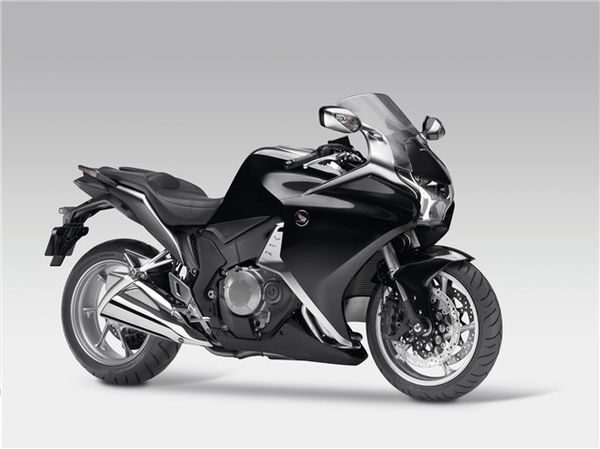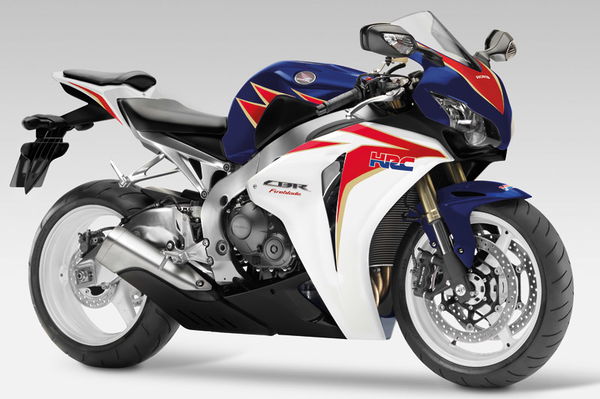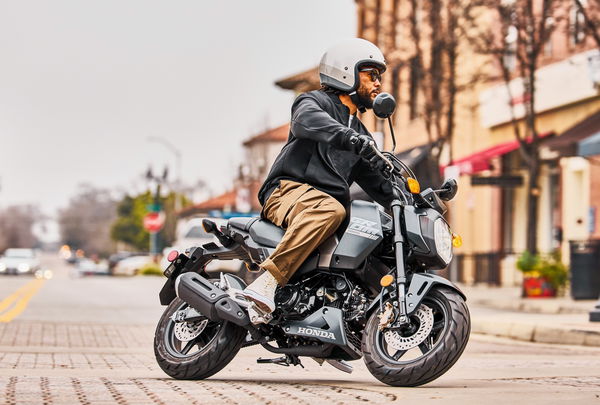New colour for 2011 Honda VFR1200F ABS
No tweaks, just a new colour for Honda's V4 sports tourer


HONDA HAVE not touched the VFR1200F ABS for 2011, but they have given us a new paint scheme. It looks right in black, we approve. Incase you missed it first time around, here's what Honda have to say about their VFR1200F ABS. Full picture gallery below.
Introduction
Introduced to Honda’s line-up in 2010, the VFR1200F was developed in keeping with previous VFRs, which have delivered a combination of sports and touring capabilities using the latest technologies. This motorcycle was, however, brand new. It was a clean-sheet interpretation of the ultimate road-sport machine – a concept driven by extensive understanding of customer needs and the adoption of state-of-the-art technologies.
In pursuit of heightened levels of control and feedback, the VFR1200F adopted the latest race-track bred technologies, but adapted and evolved to create a machine that can be many things to many riders. The harmonic growl of the flexible and responsive V4 motor may rekindle the emotions inspired by previous iconic VFRs, but its unique ‘heartbeat’ engine feel and an unrivalled level of manageability set the new VFR apart, not only from its forbears - but also from every bike currently available.
For 2011, the VFR1200F is available in a luxurious new Darkness Black Metallic / Digital Silver Metallic colour version, selected to emphasise the highly-polished look, smooth texture and unique shapes and layers of its bodywork.
Development concept
A truly international design team included three Japanese members, one American and one European. Guided by the infinitely experienced Kishi-san (CBR1100XX Blackbird) and overseen by Large Project Leader Hasegawa-san, the VFR1200F’s design team was not only culturally varied but also spanned generations. Their collective goal was to create a sports bike with long-distance capabilities. To foster the right mindset the designers imagined waking up to a perfect day and deciding, impulsively, to ride 300km, effortlessly devouring large stretches of highway before carving through twisty canyon roads, just to enjoy lunch in a beautiful location before riding home again.
The VFR1200F designers began sketching their ideas in a remote hotel outside Rome. These sketches took many forms and explored every possibility, but, rather than refine these elements into one final design, the team headed back to Tokyo with all their individual drawings.
On the VFR1200F project, designers and engineers worked in parallel, discussing and perfecting their solutions as the clay model and sketches evolved. European designer, Teofilo Plaza, described this six month-long experience as one of the most intense and passionate of his life. Once the basic design had been agreed, another many months of testing and development lay ahead – a period in which designers and engineers continued to work in unison.
The first V4 Concept model was unveiled to a stunned audience at the Intermot show in October 2008. The radically styled concept bike perfectly displayed the free thinking that had absorbed the design team from day one of this revolutionary project. At its 2009 launch, while the V4 heritage of the VRF1200F may have been patently obvious, it was evident that this machine far surpassed anything that had gone before.
Styling
The designers were clear about one subtle but important aspect of their task. This was not to be a Japanese motorcycle designed as Europeans would do it. It was to be a Japanese bike designed in Europe, with two threads of Japanese culture running through the design process.
The Japanese word ‘Ma’ has many meanings and no direct translation but in essence it can be described as ‘the space between things’. By focusing on the space around an object we can gain a new perspective on the overall form. The visible connects to the invisible and gives it shape. It is perhaps easiest to understand it in relation to music. If one thinks of the intrinsic importance of a measure of silence or the pause between movements in a classical symphony and the effect it has on the performance overall if someone accidentally applauds or disturbs that silence, that illustrates the importance of ‘Ma’.
Like Ma, ‘Tsuya’ is not a physical property. Rather, it describes the lust one can have for an object, its charm, the way it attracts and holds the eye. Focusing on tsuya brings a form to life, giving a new significance to every line, curve and angle.
To a larger degree, pure function determined the VFR1200F’s form. Mass centralisation, consummate rider control and aerodynamic efficiency provided the key underlying engineering design criteria and from this starting point the machine’s form evolved. The remarkably narrow cylinder heads and clever cylinder spacing allowed a very narrow waist, effectively lowering the seat height and thus making it easier for the rider to place both feet flat on the ground at rest. This wasp-like waist also gives the rider the feeling of being ‘in’ the bike rather than perched on top – crucial for feedback and control. The fuel tank’s elegant contours have purpose as well as eye-pleasing aesthetics in mind. Its shape and form supports and assists the rider to add extra elements of control and heightened levels of feedback whatever the riding situation. The ergonomically styled fairing works in harmony with the fuel tank to provide extra support and efficient weather protection for the rider and pillion. Even the hand controls and switchgear, with their revised button positioning are engineered to ergonomic advantage. The pillion’s comfort and security have not been overlooked either. The supportive, vacuum-moulded dual-seat has a flat and expansive area for the pillion and strong, easy-reach grab handles and footrests positioned with comfort and security in mind.
Layered Fairing technology
The patented layered fairing design of the VFR1200F is a perfect match of form and function. Designers and engineers worked together to create a uniquely beautiful shape and, at the same time, optimal air flow and heat management. The fairing design incorporates two layers, which harnesses the benefits of flowing air to the machine’s dynamic and mechanical advantage. This has two functions; air entering between the layers and through two oval-shaped spaces in the front of the fairing is channelled in exactly the directions needed to enhance the bike’s stability at higher speeds. By effectively increasing the speed of the air by channelling it through smaller apertures before it reaches the radiators, engine cooling is optimised and the hot, exhausted air is channelled away from the rider and passenger for a cooler, more comfortable ride. The heat generated by the powerful, enclosed V4 engine is also channelled away to keep hot air away from the rider.
A balance of positive and negative surfaces gives the front of the motorcycle a light, open look while also creating a profile that slices through the wind with the least possible resistance. A strongly defined X-shape characterises the front of the machine. Concave surfaces direct the eye and air up towards the windscreen, which incorporates another air-directing aperture at its lower edge. Even the edges of the screen have been crafted to enhance stability at speed. The powerful single line-beam headlight is the same type used on the CBR1000RR Fireblade. Its light streams into two tinted LED-look strips that frame the sides of the headlight, increasing the illusion of lightness and space.
A high attention to detail and quality is evident everywhere, and every design element has been fine-tuned in tandem with engineering requirements. The cowl and body are fused together, creating one smooth, unified, aerodynamic surface. The rear design is compact and tapers upwards, emphasising the bike’s lightness and dynamic shape. The tail-light and rear indicators subtly mimic the frontal design.
New painting technologies, specially developed at the hi-tech Kumamoto factory, focused on creating top-quality colouring with the most uniform coverage. A deep clear-coat finish enhances the bodywork colour, creating a luxurious, high-class shine far above normal production standards. The mirror-like surfaces create a sharp, memorable profile that attracts attention even from a distance.
Engine
The VFR1200F engine was designed to provide its rider with high speed, quick acceleration and a strong, engaging feeling coming from the engine’s power characteristics. Honda also wanted to deliver the invigorating engine sound and feel that characterise the V4 sports bikes, but with an additional focus on comfortable, responsive power delivery. The new V4 engine’s performance is delivered where it’s most useful and most enjoyable. Its linear torque curve is focused in the low and mid range, making it possible for the rider to simply roll on and off the throttle while powering through bends. This effortless control makes the bike great fun to ride – this is a sports bike with real-world usable power.
Smooth delivery
There were several challenges involved in tailoring the strong V4 power for use in an all-round machine that can be used for weekend enjoyment, commuting and long-distance touring. Key elements of the VFR1200F’s power characteristics are its unrivalled response and strong torque delivery. To allow full enjoyment of the engine’s power while still providing a high level of comfort, vibration needed to be carefully managed. A unique cylinder layout was developed for this purpose. Instead of the traditional V4 cylinder configuration, with the cylinders evenly spaced front-to-rear, the VFR1200F adopts an ingenious solution in order to centralise mass and at the same time achieve a compact, space-saving solution. The rear cylinders are placed side by side but close together, while the front cylinders are more widely spaced. This layout allows for a slim, compact ‘waist’ that fits comfortably between the rider’s legs. It also supports mass centralisation, thus contributing to the bike’s balanced feel and ease of control. With no right-left couple imbalance, the need for a balancer is eliminated and friction is reduced.
A new Phase-shift Crankshaft complements the advantages of the cylinder layout. Operating with a 28° throw, it effectively reduces primary vibration and noise, eliminating the need for a power-sapping balance shaft. The new V4 typically produces more than 90% of its maximum torque (129Nm/8,750 rpm) at 4,000rpm. To allow the rider to comfortably take full advantage of this torque, delivery is smoothed by four drivetrain dampers, which further eliminate uncomfortable vibration and backlash.
A new Phase-shift Crankshaft complements the advantages of the cylinder layout. Operating with a 28° throw, it effectively reduces primary vibration and noise, eliminating the need for a power-sapping balance shaft. The new V4 typically produces more than 90% of its maximum torque (129Nm/8,750 rpm) at 4,000rpm. To allow the rider to comfortably take full advantage of this torque, delivery is smoothed by four drivetrain dampers, which further eliminate uncomfortable vibration and backlash.
Racing technologies
The VFR1200F utilises the UNICAM single overhead camshaft cylinder head design from the world-class CRF motocrossers. The logic was straightforward: in an environment where space, performance and weight are at a premium this technology was perfect for a project where mass centralisation and ergonomics were prime design criteria. Also borrowed from the CRF range and the RC211V is the sealed crankcase system that reduces the pumping loss created through piston movement, and air density. This system has never been used on a road machine before but the gains for the rider are identical - electrifying throttle response and improved fuel consumption.
New transmission layout and ground-breaking shaft drive system
A compact new transmission layout contributes to high-speed stability, better cornering and improved traction capability. The highly developed shaft drive system features an offset propeller shaft and a pivot that expands vertically as well as a sliding constant velocity joint that takes up any variations in length during the rear wheel’s arc of travel. At the output shaft a clutch damper absorbs backlash effectively. Thanks to the rigidity of the pivot, stability is improved and throttle-to-drive delivery is much more direct.
Refined control
A throttle-by-wire system improves the rider’s connectivity with the VFR1200F. Providing light, precise fuel metering at all engine parameters this highly developed accuracy gives the rider increased levels of control, whatever the situation. It is another individual aspect that adds to the heightened feelings of response and control.
To aid control under intense deceleration a slipper clutch is fitted, similar to the system on the CBR1000RR Fireblade. Even under the most excessive downshifting the clutch is designed to slip, thus preventing the rear wheel from inadvertently locking up, allowing the rider to stay firmly in control.
Unique exhaust and exhilarating sound
Engineers and designers alike focused not only on the new engine’s power and delivery, but also on its feel and sound. They chose a configuration which would emulate the briskness of a typical inline-4 engine’s performance but deliver this with the beat and feel that are pure V4. The exhaust layout was made as compact as possible with the assembly of catalyser-containing exhaust pipes placed on one side of the sump and the exhaust pipes of the rear cylinder bank placed on the other side. On the bike’s right flank a handsome triangular-shaped muffler highlights the styling lines of the bodywork. The combined induction and exhaust notes create a raw, compelling sound that is authentic Honda V4 and distinguishes the VFR1200F from any other motorcycle. At idle it pulses smoothly, hinting at the engine’s huge performance potential. Each twist of the throttle releases a burst of instant V4 aggression that becomes a thrilling howl as it rises quickly through the revs. The sound and beat of this engine contribute to the unique character of this new sports bike and are as essential to the design as the bodywork or riding position.
A key element in the raw emotion of this V4’s sound is the exhaust system. Engineered to provide excellent cornering clearance and minimal intrusion to the rider’s and pillion’s feet, the high-volume, twin outlet high-chrome muffler produces an unobtrusive but fantastically stirring note. At low revs the noise is off-beat and bass-rich. Further up the rev range, once the servo-operated valve is opened, the noise changes to a truly inspiring, hard-edged V4 howl to stir the emotions.
Chassis
The VFR1200F frame, suspension and drive components are brought together in a unique configuration that facilitates both sports bike power and smooth stability. Its strong aluminium twin-spar diamond configuration frame is both lightweight and rigid. The swingarm and driveshaft length are optimised without extending the overall length of the motorcycle. The long swingarm contributes to balanced, confident manoeuvring and exceptional high-speed stability.
The swingarm is complemented by a compliant Pro-Link rear shock absorber with adjustable rebound damping. At the front, sturdy 43mm telescopic forks with adjustable preload provide smooth and assured control. Together, these systems ensure a comfortable ride, even with a pillion and luggage on board, and add to the overall feeling of total control.
High-performance brakes
The VFR1200F is equipped with the most highly developed brake technology for all-round sports bike use. Powerful six-piston calipers for the front and two piston calipers for the rear act on large discs (320mm at the front and 276mm at the rear). A Combined Braking System creates the optimal balance of front and rear braking forces. The addition of a standard-fit compact and lightweight ABS supports both the motorcycle’s sports riding potential and its touring proficiency.











